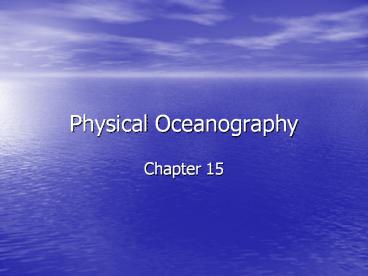Physical Oceanography - PowerPoint PPT Presentation
1 / 8
Title:
Physical Oceanography
Description:
Physical Oceanography Chapter 15 Branches of Oceanography Physical Oceanography - study of the motions of seawater, particularly waves currents and tidal motion. – PowerPoint PPT presentation
Number of Views:571
Avg rating:3.0/5.0
Title: Physical Oceanography
1
Physical Oceanography
- Chapter 15
2
Branches of Oceanography
- Physical Oceanography - study of the motions of
seawater, particularly waves currents and tidal
motion. - Chemical Oceanography - chemistry of seawater and
reactions between the atmosphere and hydrosphere.
More recently looks at how changes in seawater
temperature (El Nino) and salinity affect global
climate.
3
- Biological Oceanography - study of life in the
oceans, includes marine biology and ecology. - Geological Oceanography - study of the shape and
geologic features of the ocean floor.
4
Major Oceans
- The three major oceans are
1._______-largest,
deepest, coldest, least salty. 2.__________-
second largest, shallow, warm, salty.
3.
_________- intermediate in depth, temperature,
and salinity. - The _______Ocean near the north pole, and the
____________ Ocean near the south pole contain
vast expanses of sea ice.
Pacific
Atlantic
Indian
Arctic
Antarctic
5
Methods of Studying the Ocean
The Topex/Poseidon _____________ orbits 1331 km
above the Earth, gathering information about the
oceans.
satellite
Sonar
_____________ maps ocean floor topography by
timing how long it takes sound waves to bounce
off the ocean floor.
submersibles
Underwater vessels called _________________
investigate the deepest ocean trenches.
6
Sonar (also called echo-sounding)
- Sound waves travel how fast in seawater?
- How deep is the water if it takes ten seconds for
the sound wave to go from ship to ocean floor and
back to ship?
1,454 m/s
7,270 m
Calculation (10 s times 1,454 m/s divided by 2 )
7
submersible
- The picture below is of a _____________.
8
Salinity
The amount of salt per unit water is known as
salinity.
NaCl
The most abundant salt in seawater is ________,
but there are many other salts present in the
form of ions.
The average salinity of seawater is _____ ppt.
Therefore, for every 1,000 ml water, there are
___ grams of dissolved salts.
35
35
Near the equator salinity is __________ than
average due to ___________________.
lower
greater precipitation
lower
Near the poles salinity is __________ than
average due to _______________.
melting sea ice
higher
In the Mediterranean the salinity is
__________than average due to __________.
evaporation































